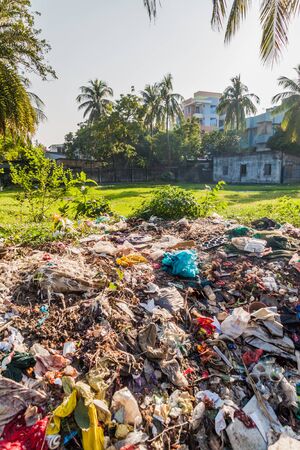1. Introduction: The Need for Plastic-Free Initiatives in Indian Schools
India, a vibrant nation with a rapidly growing population, faces an escalating challenge of plastic pollution. From bustling cities to quiet villages, single-use plastics have become an everyday convenience but also a significant environmental threat. This issue is particularly evident in the education sector, where plastic waste accumulates through daily tiffin boxes, water bottles, packaging, and classroom supplies. As the country strives for sustainable development, it is crucial to address these concerns within schools, which are not just centers of learning but also the cradle for shaping young minds. By making Indian schools plastic-free zones through camps and workshops, we can instill eco-conscious values among students from an early age. Nurturing such habits aligns with traditional Indian wisdom that respects nature and community living, making educational institutions ideal spaces to drive this change. These initiatives not only reduce immediate environmental impact but also empower the next generation to lead India towards a greener, cleaner future.
Cultural Context: Traditional Indian Practices and Sustainable Living
India’s rich cultural heritage offers a treasure trove of eco-friendly practices that seamlessly align with the goals of plastic-free camps and workshops in schools. For generations, Indian households have championed sustainable living through resourceful waste management and daily routines. By tapping into these time-tested traditions, schools can cultivate environmentally conscious mindsets among students in a way that feels familiar and practical.
Highlighting Everyday Wisdom
In many Indian homes, the use of steel tiffin boxes (dabba) for carrying lunch, cloth bags for shopping, and banana leaves as natural plates have been integral to daily life. These alternatives are not only reusable but also deeply rooted in local customs. Introducing such items into school camps and workshops provides children with tangible examples of zero-waste solutions drawn directly from their own cultural backgrounds.
Traditional Practices vs. Plastic Alternatives
| Traditional Item | Plastic Alternative | Sustainable Benefit |
|---|---|---|
| Steel Lunchbox (Dabba) | Plastic lunch container | Durable, non-toxic, infinitely reusable |
| Cloth Bag (Jhola) | Plastic carry bag | Biodegradable, washable, supports artisans |
| Banana Leaf Plate | Disposable plastic plate | Compostable, chemical-free, locally available |
Adapting Traditions in School Settings
During camps and workshops, schools can encourage students to bring meals in steel dabbas and use cloth napkins instead of paper tissues. Group activities can include DIY sessions where students create upcycled crafts using old saris or learn how to make simple cloth bags. Meals served on banana leaves during events not only reduce plastic waste but also offer a hands-on experience of traditional hospitality. By celebrating these indigenous solutions, schools empower children to become ambassadors of sustainability in their communities.

3. Implementing Plastic-Free Policies: Practical Steps for Schools
Creating plastic-free camps and workshops in Indian schools is not just about banning single-use plastics, but about fostering a culture of sustainability rooted in local traditions. Here are some actionable steps to guide your school community:
Source Eco-Friendly Alternatives
Start by replacing common plastic items with sustainable, locally sourced alternatives. For serving food and drinks, consider using kulhads (traditional clay cups), leaf plates (such as those made from sal or banana leaves), and steel tumblers. Decorate your venue with cloth banners instead of vinyl flexes, and use reusable fabric bunting. These alternatives not only reduce plastic waste but also celebrate Indian craftsmanship and culture.
Waste Segregation & Management
Set up clearly marked bins for wet and dry waste at strategic points around the camp or workshop area. Involve students and teachers in a quick orientation on proper waste segregation. Compostable items like leaf plates can be collected separately for composting, while recyclables like paper can be sent to local kabadiwalas (scrap dealers). Ensure that there are volunteers or staff overseeing the waste stations to guide participants.
Involving Local Vendors & Community
Engage local vendors who supply eco-friendly materials, such as potters for kulhads or artisans for cloth decorations. This supports the local economy and ensures authenticity in your events. Collaborate with community groups or NGOs that specialize in waste management to provide training and resources for your school’s staff and students.
Guidelines to Ensure Success
- Create a checklist of items needed for a plastic-free event, ensuring all purchases prioritize biodegradable or reusable options.
- Conduct awareness sessions before the event so everyone understands the importance of going plastic-free.
- Reward students, staff, and vendors who contribute positively towards the campaign, reinforcing positive behavior.
Together Towards a Greener India
By taking these practical steps, Indian schools can lead by example in promoting a plastic-free lifestyle—one that respects our environment and honours our heritage.
4. Student & Teacher Engagement: Creating Ownership and Awareness
For plastic-free camps and workshops in Indian schools to be truly impactful, active engagement of both students and teachers is essential. This involvement goes beyond simple participation—it’s about instilling a sense of ownership, pride, and responsibility towards the environment. By weaving interactive activities into the programme, schools can ignite enthusiasm and deepen understanding of why a plastic-free lifestyle is important for India’s future.
Ideas for Interactive Activities
Interactive sessions ensure learning is not only educational but memorable. Here are some locally relevant ideas:
| Activity | Description | Indian Context |
|---|---|---|
| Street Plays (Nukkad Natak) | Students perform short plays highlighting the dangers of plastic pollution and alternatives. | Utilises the popular Indian tradition of public theatre to reach wider audiences, including parents and local communities. |
| Poster-Making Competitions | Students design creative posters with slogans in English and regional languages promoting plastic-free living. | Encourages artistic expression while spreading awareness across linguistic groups. |
| Eco-Brigades (Prakriti Sena) | Formation of student groups responsible for monitoring and maintaining plastic-free zones on campus. | Cultivates teamwork, leadership, and a sense of duty aligned with the concept of ‘Seva’ (selfless service). |
Integrating Environmental Learning with Indian Values
Sustainability has deep roots in Indian culture—from Mahatma Gandhi’s philosophy of minimalism to traditional practices that respect nature (‘Prakriti’). Teachers can connect environmental lessons with stories from Indian epics, proverbs, or folk wisdom about living in harmony with the earth. Incorporating yoga sessions focused on mindful consumption or discussions about Swachh Bharat Abhiyan further ties global eco-principles with national pride.
Empowering Student Leaders as Change Agents
Selecting enthusiastic students as “Green Ambassadors” helps drive peer-to-peer education. These young leaders can organise school assemblies, lead clean-up drives, conduct audits on plastic use, and represent their school at local eco-events. Providing them with badges, certificates, or opportunities to interact with environmentalists fosters motivation. Teachers serve as mentors, guiding these leaders while ensuring inclusivity—so every child feels they are part of India’s journey towards a cleaner tomorrow.
5. Community Involvement: Inviting Parents and Local Stakeholders
Building a plastic-free culture in Indian schools goes beyond students and teachers. True impact is achieved when the entire community becomes involved. To make plastic-free camps and workshops truly successful, engaging parents, NGOs, and local businesses is vital.
Engaging Parents for Sustainable Change
Parents play a crucial role in reinforcing plastic-free habits at home. Schools can organise orientation sessions where parents are invited to learn about the harmful effects of single-use plastics and how they can support their children’s new habits. Sharing simple, locally relevant alternatives—such as using steel tiffin boxes, cloth bags, or banana leaves—makes it easy for families to adopt change. Encouraging parents to volunteer during camps also helps build a sense of ownership and collective responsibility.
Partnering with NGOs for Awareness
Non-governmental organisations (NGOs) often have expertise in environmental education and resources for community outreach. Collaborating with NGOs allows schools to conduct interactive sessions, street plays, or clean-up drives that extend beyond the school campus. These partnerships can also help identify sustainable vendors for event supplies and create awareness campaigns in regional languages to reach wider audiences.
Involving Local Businesses and Vendors
Local businesses are key stakeholders in creating sustainable events. Schools can encourage nearby shops to provide discounts on eco-friendly products or sponsor reusable items for camps and workshops. Working with street food vendors and canteens to use biodegradable packaging instead of plastic helps set an example for the whole community. Celebrating these partners in school newsletters or social media motivates others to join the movement.
Creating a Ripple Effect
The combined efforts of families, NGOs, and businesses foster a supportive environment where sustainability becomes part of daily life. By inviting all stakeholders to participate in plastic-free initiatives, Indian schools act as catalysts for broader societal change—promoting not just greener campuses but cleaner neighbourhoods across India.
6. Challenges and Solutions: Overcoming Barriers in the Indian School Context
Implementing plastic-free camps and workshops in Indian schools is an inspiring initiative, but it comes with unique challenges rooted in local realities. Understanding these hurdles is crucial for creating practical and lasting change.
Cost Concerns: Making Eco-Friendly Choices Affordable
Many schools, especially in rural or low-income areas, are concerned about the higher perceived cost of sustainable alternatives to plastic. However, by opting for reusable steel tiffins, cloth bags made by local women’s groups, or even repurposed glass jars, costs can be minimized while supporting the local economy. Schools can also initiate donation drives where students bring extra containers from home, making the transition more accessible.
Convenience Culture: Shifting Habits Gently
The convenience of single-use plastics is deeply ingrained in daily routines. To address this, workshops can demonstrate simple DIY alternatives using materials commonly found at home. For example, teaching students to make their own paper bags or banana leaf plates—drawing on traditional Indian practices—encourages pride in cultural heritage while reducing reliance on plastic.
Lack of Awareness: Building Knowledge Step-by-Step
Awareness about the environmental impact of plastic waste is still growing in many communities. Interactive sessions using storytelling, street plays (nukkad natak), and visual displays in local languages can help bridge this gap. Involving parents and local leaders ensures that the message reaches beyond school walls and becomes a community effort.
Locally-Informed Solutions: Tapping Into Indian Wisdom
India has a long history of eco-friendly living—clay cups (kulhads), jute bags, and leaf plates are just a few examples. Reviving these traditional practices not only reduces plastic use but also reconnects students with their roots. Partnering with local artisans to supply schools with sustainable products further strengthens community bonds.
Together Towards Change
By addressing cost concerns through collective action, challenging convenience culture with creative alternatives, and building awareness using culturally relevant methods, Indian schools can lead the way towards a plastic-free future. Every small step counts when it is guided by local knowledge and a shared commitment to sustainability.
7. Success Stories: Inspiring Examples from Indian Schools
Across India, schools are rising to the challenge of reducing plastic waste by organizing innovative plastic-free camps and workshops. These real-life success stories offer both inspiration and practical insights for others looking to follow in their footsteps.
Kendriya Vidyalaya, Delhi: Leading Change in the North
Kendriya Vidyalaya in Delhi took a bold step by hosting a week-long plastic-free camp on campus. Students and teachers collaborated to create eco-friendly decorations using cloth and paper, replacing all single-use plastics. The camp included interactive sessions where students learned about waste segregation and the harmful effects of plastic pollution on the Yamuna River. Their efforts resulted in zero-plastic events during the school year and inspired nearby schools to adopt similar practices.
Bishop Cotton Boys’ School, Bengaluru: Southern Sustainability
In Bengaluru, Bishop Cotton Boys’ School organized workshops that focused on everyday alternatives to plastic—like cloth bags, steel lunchboxes, and compostable plates. Students participated in DIY sessions to craft reusable items from old clothes and newspapers. The initiative was embraced by parents, who joined hands with the school to promote a ‘Bring Your Own Bottle’ policy. The school has since reported a significant drop in plastic litter within its premises.
Sri Chaitanya Techno School, Hyderabad: Spreading Awareness
Sri Chaitanya Techno School ran an awareness campaign alongside their plastic-free workshop. Children designed posters in Telugu and English highlighting the importance of saying “No” to single-use plastics. They also conducted street plays in their neighborhoods, spreading the message beyond the classroom. This outreach effort encouraged local vendors to reduce plastic packaging—a small but meaningful community shift.
Rural Roots: Government High School, Kerala
In rural Kerala, the Government High School organized a ‘Green Camp’ where students learned traditional Indian methods of storing food using earthenware and banana leaves. The school introduced a weekly market where parents could buy fresh produce without any plastic packaging. This practical approach preserved local culture while championing environmental stewardship.
Key Learnings and Celebrating Achievements
These case studies show that Indian schools—whether urban or rural—can lead impactful change by harnessing creativity, community support, and culturally relevant solutions. Their triumphs demonstrate that going plastic-free is not just possible but can be celebrated as a movement towards a cleaner, greener Bharat.


